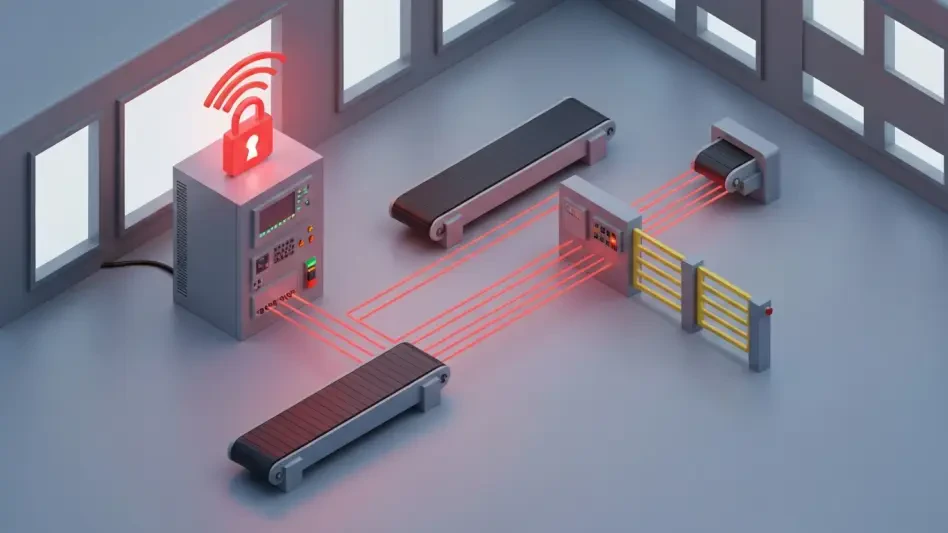What happens when a single cyberattack can paralyze an entire industry, costing billions in mere hours, and how can organizations prevent such catastrophic losses? This isn’t a far-fetched scenario but a pressing reality for industrial systems worldwide. Operational Technology (OT) cybersecurity breaches are hitting organizations with devastating financial blows, with potential annual losses soaring to a staggering $329.5 billion in a worst-case scenario. From halted production lines to crippled energy grids, the impact reverberates through economies, demanding immediate attention to a crisis unfolding in the heart of critical infrastructure.
The importance of this issue cannot be overstated. With $172.4 billion of these annual losses tied directly to business interruptions, as highlighted by recent cybersecurity analyses, OT breaches threaten not just profits but the stability of essential services. This feature dives into the unique vulnerabilities of OT environments, unpacks the root causes behind the astronomical costs, and amplifies expert voices on solutions. It’s a story of urgent risks and actionable strategies, revealing why securing industrial systems has become a top priority for executives and policymakers alike.
Unveiling the Financial Disaster in Industrial Systems
In the shadowy world of industrial operations, a silent catastrophe brews as cyberattacks target the very machinery that powers economies. Unlike data breaches that expose sensitive information, OT incidents strike at physical processes—think factory floors grinding to a standstill or water treatment plants failing. The financial wreckage is immense, with losses mounting into the hundreds of billions annually, painting a grim picture for industries unprepared for such disruptions.
This isn’t merely about numbers on a balance sheet; it’s about real-world consequences. A single breach can cascade through supply chains, halting production across multiple sectors and driving up costs for businesses and consumers alike. The urgency to address this crisis grows as more organizations recognize that their critical infrastructure hangs in a precarious balance, vulnerable to increasingly sophisticated threats.
Exposing the Fragility of OT Environments
OT systems, which control everything from manufacturing robots to power grids, stand apart from traditional IT setups due to their direct link to physical operations. A breach here doesn’t just compromise data—it can shut down entire facilities or endanger public safety. This unique exposure, coupled with outdated defenses and obscure industrial protocols, makes OT environments a goldmine for cybercriminals seeking maximum disruption.
Compounding the problem is a startling lack of visibility. Many executives remain unaware of the full scope of their OT assets, leaving blind spots that attackers exploit with ease. With business interruptions alone costing $172.4 billion each year, the fragility of these systems underscores a critical need for specialized security measures tailored to industrial realities.
Dissecting the High Price of Breaches and Their Triggers
The financial devastation from OT breaches arises from a toxic mix of factors. Business interruptions lead the charge, as halted operations ripple through supply chains, stalling revenue and inflating recovery costs. Real-world cases, like the Colonial Pipeline attack in recent years, demonstrate how a single incident can paralyze fuel distribution across regions, sending economic shockwaves far beyond the initial target.
Beyond downtime, the disconnect between IT and OT security tools creates gaping vulnerabilities. Standard firewalls and antivirus programs often fail against industrial-specific threats, while ransomware tailored for critical infrastructure escalates the damage. These root causes, backed by a decade of breach data, reveal why losses spiral into billions and why generic solutions fall short in protecting industrial lifelines.
Hearing from the Frontlines: Experts Weigh In on OT Threats
Industry leaders are raising a unified alarm about the scale of OT cybersecurity risks. Robert M. Lee, CEO of a leading cybersecurity firm, argues that framing OT risks in financial terms—potentially $329.5 billion annually—shifts the conversation from technical jargon to boardroom urgency. This perspective drives home the necessity for strategic investment in defenses that match the stakes.
Other voices echo similar urgency with actionable insights. Mark Stacey, a senior figure in the field, champions comprehensive asset inventories and relentless monitoring as cornerstones of threat detection. Meanwhile, Chad Cragle from a managed security provider emphasizes tailored anomaly detection for industrial protocols, noting the dual threat to operations and safety. Thomas Wilcox, a channel expert, points to adversarial AI as an emerging danger, advocating for AI-powered defenses to keep pace with rapid, evolving attacks.
Building Defenses: Practical Steps to Curb OT Cyber Losses
Reducing the financial fallout from OT breaches demands concrete, data-backed strategies. Incident response planning tops the list, slashing risk by up to 18.5% through swift containment of incidents. This preparation ensures that organizations aren’t left scrambling when an attack strikes, minimizing downtime and associated costs.
Equally vital is the creation of a defensible architecture, incorporating hardened systems and segmented networks, which cuts risk by as much as 17.09%. Alongside this, ICS network visibility and monitoring offer a 16.47% risk reduction by enabling real-time threat detection. Experts also stress the adoption of purpose-built OT technologies over generic IT fixes, paired with detailed asset inventories and AI-driven tools to bolster response times and fortify industrial environments against relentless cyber threats.
Reflecting on a Path Forward
Looking back, the battle against OT cybersecurity breaches has exposed a monumental challenge, with annual losses that could reach nearly $330 billion weighing heavily on industries. The distinct vulnerabilities of industrial systems have demanded far more than off-the-shelf solutions; they require specialized controls and unwavering commitment from leadership.
Moving ahead, organizations must prioritize incident response planning, robust architectures, and persistent monitoring to shield against devastating disruptions. Embracing AI-driven defenses and comprehensive asset visibility stands as a critical next step to outpace sophisticated threats. The journey to secure OT environments remains ongoing, but with targeted action and collaboration, the tide can turn against a crisis that once threatened to overwhelm critical infrastructure.








